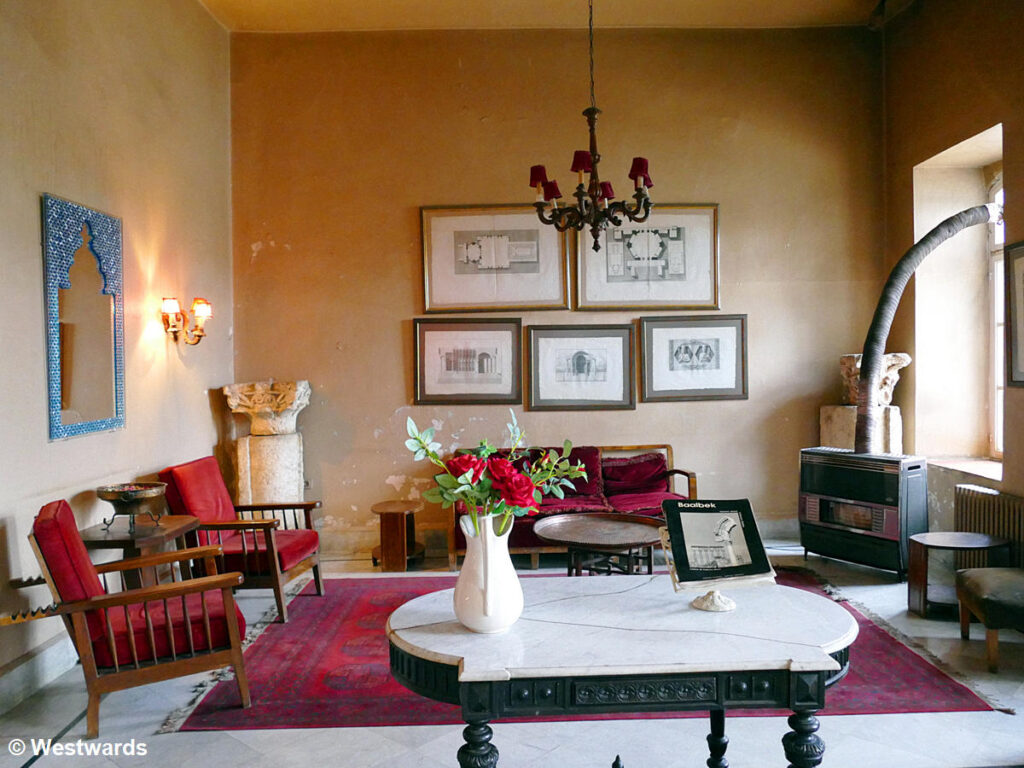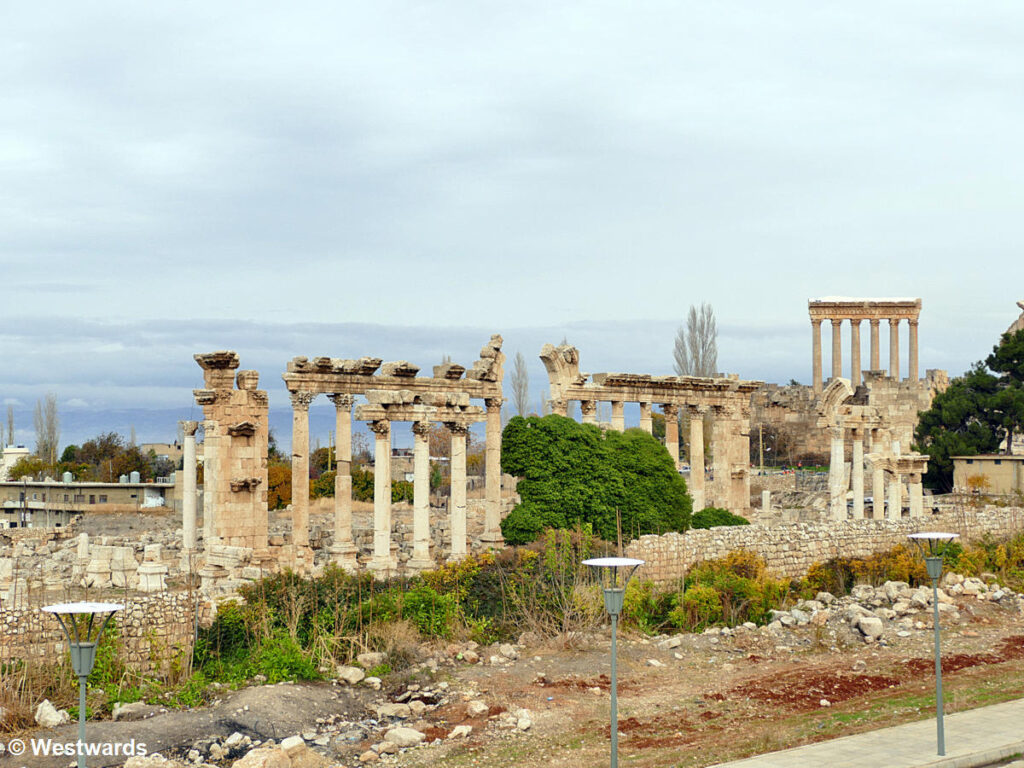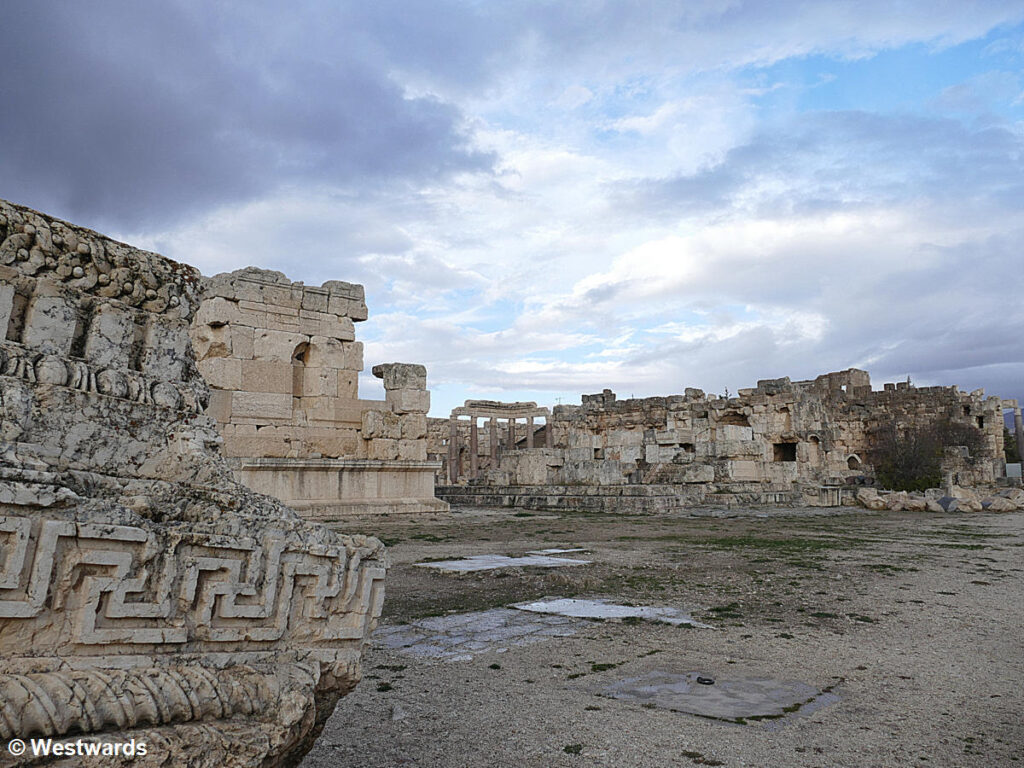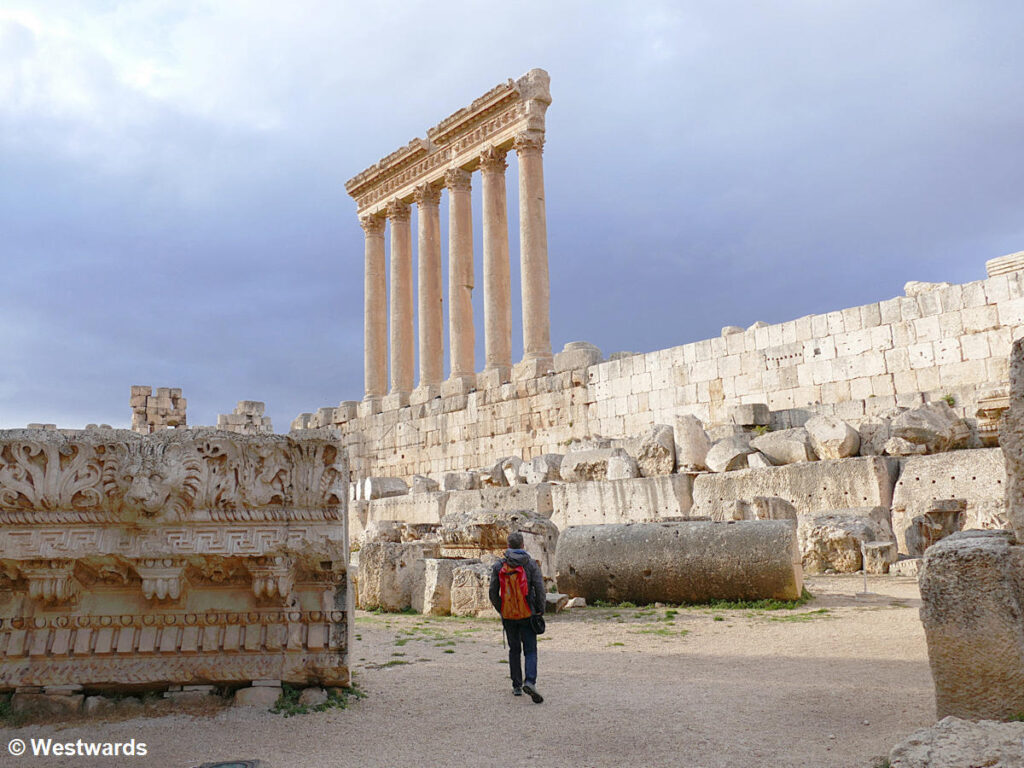
Close to the Syrian border, the monumental temple complex of Baalbek is one of the largest remaining Roman structures in the world and a UNESCO World Heritage site. On a winter day during the Lebanese revolution with very few other visitors, it was a stunning experience to visit the Roman temples in Baalbek.

When we arrive at the iconic Hotel Palmyra in Baalbek, old men in overcoats are warming themselves at the gas stove. The Hotel Palmyra is the oldest hotel in town. Even the German Kaiser Wilhelm II stayed here when he visited the Holy Land back in 1898. The charming grand lobby appears rather unchanged since then.

We have come to Baalbek using several minibuses from Beirut. It is already noon by the time we arrive and we are eager to explore the famous Baalbek we can already see opposite the hotel entrance. But first, we search the tiny village of Baalbek for some food – eventually ending up with an espresso and an Ülker chocolate bar at a kiosk. Another customer orders two hot teas, lengthily deliberating.
“Umm, no, no black tea, I think I would prefer the lemon verbena herb tea”
Which happens to be on the top shelf and quite difficult to reach for the elderly vendor …
Enormous Roman temples
Just behind the entrance to the Roman temples of Baalbek some flights of stairs lead to the main buildings – the huge Roman temple took up the site of ancient settlements, the remains of which were already rising several meters above the ground.

It takes us quite a while just to explore the propylaea and the courtyards – carved columns and niches everywhere. The main courtyard alone, with remains of huge altars and wash basins, is about the size of a football field.

Finally, a further flight of stairs goes up to the main temple of Jupiter Optimus Maximus Heliopolitanus, where some impressive 20 m high columns are still standing. The temple walls were so strong and stood so high above the valley that later Islamic dynasties used the temple as a fortress, adding moats and further fortifications.

Wilhelm II and the Baalbek temples
Next to the Jupiter temple we explore another, even better preserved temple. The walls of the cella are surrounded by enormous columns. Inside this so-called Temple of Bacchus, there’s a memorial plaque which Sultan Abdul-Hamid II had made to commemorate the German emperor’s visit to the Baalbek temples. Wilhelm II was so impressed by the ruins that he contributed large amounts of money and manpower to their excavation.
To this day, German archaeologists are active on the various Roman temples in Baalbek. They also set up a very informative museum in the basement rooms of the Jupiter Temple, displaying more finds, old photographs and a lot of background information.

By the time we are back in the Palmyra hotel, the event that all those old men (and very few women) had been attending has ended. Most are still in the hotel lobby discussing important issues – it seems. So, what was it about? “Oh, how do you say that in English,” a greying gentleman ponders. “You know, about our uprising!”
How to get to the Roman temples in Baalbek on public transport from Beirut
From our hotel in Hamra (Beirut) we took a public bus (1000 LBP) to the Kola bus station. Next, we went by minibus to Chtoura where we changed into another minibus to the Roman temples in Baalbek. From Kola the journey took about two hours and cost 10,000 LBP per person (around 6 €).
Since we passed Chtoura and Zahle anyway it was easy enough to stop there for a night on our return trip. From there we could also visit the early Islamic Umayyad city of Anjar, another UNESCO World Heritage site.
Accommodation in Baalbek

If you have an early start you can easily visit the Roman ruins of Baalbek as a day trip from Beirut even on public transport. We totally enjoyed our one-night stay at the famous Palmyra Hotel in Baalbek. There was no hot water and a somewhat unreliable heating and electricity system, though. Nevertheless, staying there we could visit other sights in the region the next day.
Note: We were not sponsored in any way or received money or other benefits for and during our trip to Lebanon. All expenses were fully paid by ourselves.




It seems like you had the whole sight to yourselves! I find it amazing to visit Roman ruins (around the world) and even more amazed that some are still being discovered and studied. I love all the craved details.
hmm That last question would have made me a little nervous :).
I must admit I am always stunned to find Roman ruins so far flung from Italy. I can see why the Roman Temples in Baalbek would get the UNESCO designation. The ruins are indeed enormous. And I still marvel at single column walls standing with little supports! It will be interesting to see what the archeologists continue to discover.
The Roman empire was very big and streched much further than todays Italy. It was a different state – I think we just tend to equal it with Italy because of the the capital Rome.
I think it is almost impossible to fathom the extent of the Roman Empire unless you actually see some ruins in person. It is hard to understand the vastness of their buildings from a picture, but you do a good job explaining when you compare the main courtyard to a football field.
Dear Donna, you are right. We learned a lot about the Romans in school, but only realized the size and impact of their empire, when we saw what is still left in Europe and Africa.
Roman ruins in Baalbek reminds me of Roman monuments and ruins in Merida, Spain – which is a world heritage site! It is amazing how Roman monuments and ruins are discovered in places so far away from Italy. The giant sizes of structures are truly a miracle how Romans built these in the old days. 🙂
Dear Jan, Baalbek is also a World Heritage site. The Roman ruins everywhere look pretty similar as they had a blueprint for all the cities they built in their empire.
Roman temples in Baalbek look amazing. It’s great to know that one of the world’s most significant remaining Roman structures remains. I appreciate that you give tips on how to get there by public transport from Beirut.